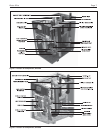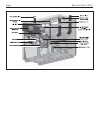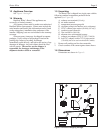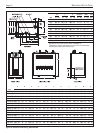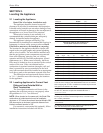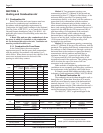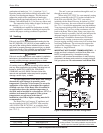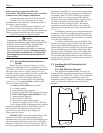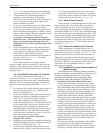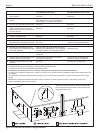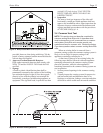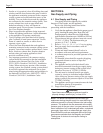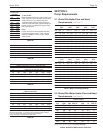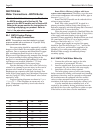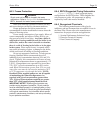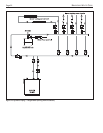
Brute Elite
Page 15
1. Figure 12 shows the requirements for mechanical
vent terminal clearances for the U.S. and Canada.
2. Vent terminals for condensing appliances or
appliances with condensing vents are not
permitted to terminate above a public walkway, or
over an area where condensate or vapor could
create a nuisance or hazard.
3. Locate the vent terminal so that vent gases cannot
be drawn into air conditioning system inlets.
4. Locate the vent terminal so that vent gases cannot
enter the building through doors, windows, gravity
inlets or other openings. Whenever possible, avoid
locations under windows or near doors.
5. Locate the vent terminal so that it cannot be
blocked by snow. The installer may determine
that a vent terminal must be higher than the
minimum shown in codes, depending upon local
conditions.
6. Locate the terminal so the vent exhaust does not
settle on building surfaces or other nearby objects.
Vent products may damage surfaces or objects.
7. If the boiler or water heater uses ducted
combustion air from an intake terminal located on
the same wall, see Figures 12-14 for proper
spacing and orientation.
If the vent termination is located in an area
exposed to high winds, an optional PVC tee (the same
diameter as the vent pipe) may be used. The tee'd vent
termination offers greater protection from wind related
operating issues.
3.3.2 Side Wall Combustion Air Terminal
The side wall combustion air terminal, or
concentric terminal (see Table 3), must be used when
the heater takes air from a side wall. Contact Bradford
White for AL29-4C termination fittings. Consider the
following when installing the terminal (see Figures 12-
14):
1. Do not locate the air inlet terminal near a source of
corrosive chemical fumes (e.g., cleaning fluid,
chlorine compounds, etc.)
2. Locate the terminal so that it will not be subject to
damage by accident or vandalism. It must be at
least 7 feet (2.1m) above a public walkway.
3. Locate the combustion air terminal so that it
cannot be blocked by snow. The National Fuel Gas
Code requires that it be at least 12 inches (30cm)
above grade, but the installer may determine it
should be higher, depending upon local conditions.
4. If the Brute Elite is side-wall vented to the same
wall, locate the vent terminal at least 1 foot (0.3m)
above the combustion air terminal.
5. For concentric vent, follow instructions
included with vent kit.
6. Multiple vent kits should be installed such that the
horizontal distance between outlet group and inlet
group is 36" (90cm) (see Figure 13).
7. Vent outlet for models 80-285 must be no lower
than the center of the air inlet, and must be at least
12" (30cm) away from the air inlet. Vent outlets
for models 399-850 must be at least 12" above the
top of the air inlet, and must be at least 36" (90cm)
horizontally from the air inlet (see Figure 14).
3.3.3 Vertical Vent Terminal
When the unit is vented through the roof, the vent
must extend at least 3 feet (0.9m) above the point at
which it penetrates the roof. It must extend at least 2
feet (0.6m) higher than any portion of a building within
a horizontal distance of 10 feet (3.0m), and high enough
above the roof line to prevent blockage from snow. The
vent terminal included with the Brute Elite can be used
in both vertical and horizontal applications. When the
combustion air is taken from the roof, the combustion
air must terminate at least 12" (30cm) below the vent
terminal (see Figure 11).
3.3.4 Vertical Combustion Air Terminal
When combustion air is taken from the roof, a
field-supplied rain cap or an elbow arrangement must be
used to prevent entry of rain water (see Figure 11). The
opening on the end of the terminal must be at least 12"
(30cm) above the point at which it penetrates the roof,
and high enough above the roof line to prevent blockage
from snow. When the vent terminates on the roof, the
combustion air must terminate at least 12" (30cm)
below the vent terminal.
3.3.5 Installations in the Commonwealth of
Massachusetts
In Massachusetts the following items are required if
the side-wall exhaust vent termination is less than seven (7)
feet above finished grade in the area of the venting,
including but not limited to decks and porches. From
Massachusetts Rules and regulations 248 CMR 5.08
1. Installation of Carbon Monoxide Detectors
At the time of installation of the side wall vented
gas fueled appliance, the installing plumber or gas-
fitter shall observe that a hard-wired carbon monox-
ide detector with an alarm battery back-up is instal-
led on the floor level where the gas appliance is to
be installed. In addition, the installing plumber or
gasfitter shall observe that a battery operated or
hard-wired carbon monoxide detector with an alarm
is installed on each additional level of the dwelling,
building or structure served by the side-wall hori-
zontally vented gas fueled equipment. It shall be the
responsibility of the property owner to secure the
services of qualified licensed professionals for in-
stallation of hard-wired carbon monoxide detectors.
a. In the event that the side-wall horizontally vented
gas fueled equipment is installed in a crawl space or
an attic, the hard-wired carbon monoxide with alarm
and battery back-up may be installed on the next
adjacent floor level.
b. In the event that the requirements of the subdivi-
sion cannot be met at the time of completion of
installation, the owner shall have a period of thirty
(30) days to comply with the above requirements,



